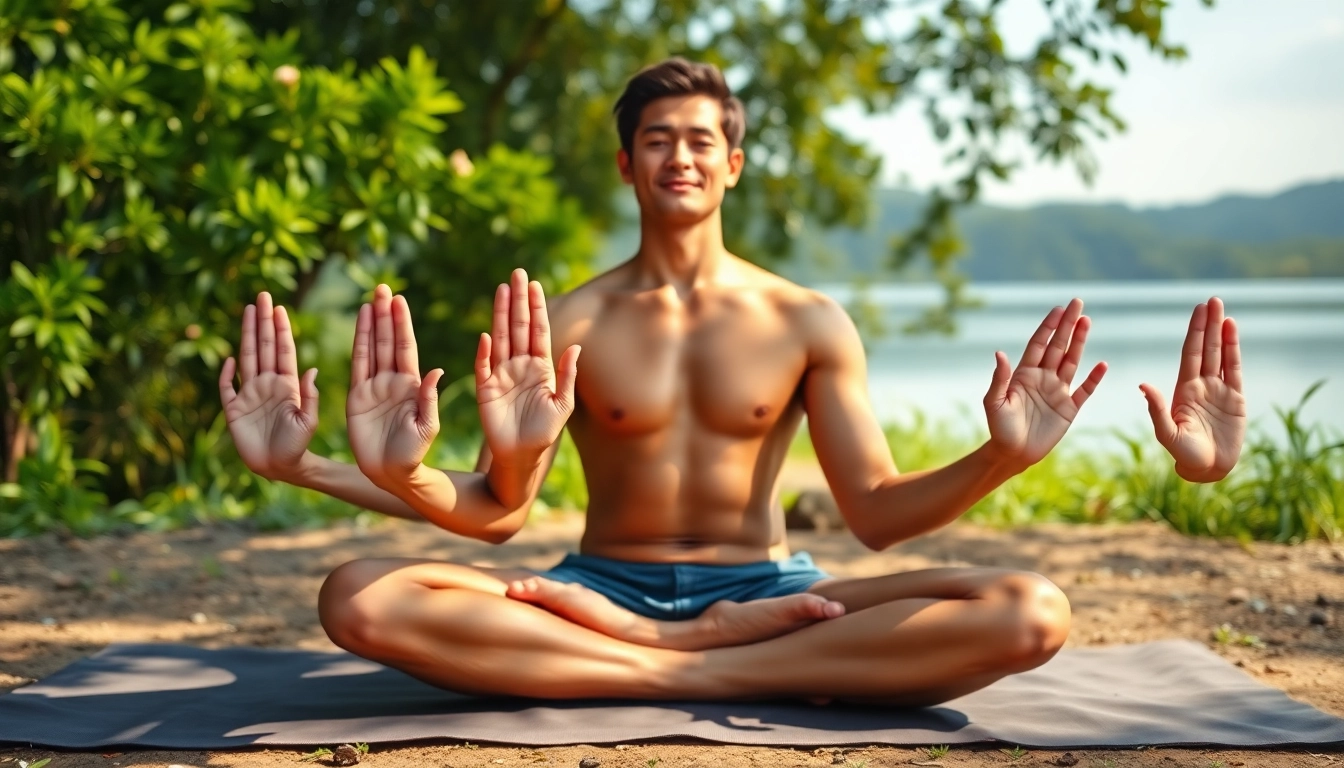Introduction to Yoga Mudras
Yoga mudras, often defined as symbolic hand gestures, function as tools for enhancing meditation and yoga practices. These intrinsic gestures have roots in ancient traditions, and while the word “mudra” may directly translate to “seal” or “gesture,” the significance of yoga mudras extends beyond mere physical movement. Integrating these hand positions into your routine can help cultivate a deeper sense of awareness, unleash energy, and even facilitate healing. For a comprehensive list of yoga mudras, you can explore this yoga mudras guide.
What Are Yoga Mudras?
At their essence, yoga mudras are intentional hand movements that serve to focus energy and deepen spiritual practices. Used predominantly in yoga and meditation, these simple gestures can influence both physical and mental states. Mudras can regulate the flow of prana, or life force, through energy channels in the body, known as nadis. While often practiced during seated meditation, these gestures can also be incorporated into various yoga poses to enhance their effects.
Mudras are often differentiated based on their purposes. Some are primarily used for meditation, while others are employed for healing or as part of a broader yoga practice. Each mudra has its unique symbolism and energetic impact, providing practitioners with a rich vocabulary for expressing their intentions.
The History and Origins of Yoga Mudras
The history of yoga mudras dates back thousands of years, with origins found in Hinduism, Buddhism, and Jainism. Ancient texts, such as the “Yoga Sutras” and “Hatha Yoga Pradipika,” reference various gestures that were integral to spiritual practices. Over centuries, these gestures have evolved and found their place in modern yoga, aiding individuals in their quest for mindfulness and connection.
Historical records indicate that the earliest practitioners believed these hand gestures could channel subtle energies within the body, unlocking potential and promoting clarity. As the practice of yoga evolved, various schools of thought integrated mudras, leading to a rich tapestry of techniques drawn from diverse philosophical perspectives.
Benefits of Practicing Yoga Mudras
The practice of yoga mudras offers numerous benefits that extend to both physical and mental health. Here are some key advantages:
- Enhanced Meditation: Incorporating mudras during meditation can deepen your focus and tranquility, allowing for a more profound experience.
- Emotional Balance: Many yogis report a sense of emotional stability and self-awareness when practicing specific mudras regularly.
- Improved Health: Certain mudras are believed to target specific physical ailments, aiding in healing and promoting wellness.
- Energy Regulation: By aligning with your breath and movement, mudras can help regulate energy flow within the body, enhancing vitality.
In addition to these benefits, many practitioners find that mudras serve as a practical yet profound form of self-expression. They are a non-verbal way to communicate intentions, making each practice unique and personal.
Types of Yoga Mudras
Understanding the various categories of yoga mudras is vital for harnessing their full potential. Below, we discuss different types of mudras categorized by their purposes.
Hand Mudras for Meditation
Hand mudras play a significant role in meditation practices. They not only help generate a grounding connection but also serve to facilitate energy flow. Here are some popular hand mudras specifically designed for meditation:
- Gyan Mudra: This gesture is achieved by touching the tip of the thumb to the tip of the index finger. It’s known as the “Mudra of Knowledge,” promoting concentration and enhancing mental clarity.
- Chin Mudra: Similar to Gyan Mudra, but the palm faces upwards. This mudra is thought to bring about calmness and enlightenment.
- Namaste Mudra: Practiced with palms pressed together at the heart center, this gesture symbolizes respect and unity, facilitating a sense of connection with the divine.
Each of these hand mudras offers different benefits, and experimenting with them can help practitioners discover which mudra resonates most deeply with their personal practice.
Healing Mudras and Their Applications
Beyond their use in meditation, yoga mudras can also serve specific health-related purposes. Healing mudras are designed to address particular ailments or emotional states. Here are a few widely practiced healing mudras:
- Apan Vayu Mudra: This mudra is believed to help with heart and digestion issues. It’s performed by folding the index and middle fingers down while extending the ring and little fingers and connecting them to the thumb.
- Shankh Mudra: This gesture symbolizes the conch shell. It helps to reduce stress and enhance focus. It is performed by interlocking your fingers while holding the index finger upright, representing the shell.
- Vayu Mudra: This mudra is ideal for addressing ailments related to air, such as anxiety and nervousness. It is created by folding the index finger to touch the base of the thumb while keeping the other fingers extended.
The application of these healing mudras varies, and practitioners can choose which ones to use according to their individual needs. Regular practice can lead to noticeable improvements in physical and emotional health.
Specific Yoga Mudras for Daily Practice
Integrating specific yoga mudras into your daily routine can enhance overall well-being. Here’s a selection of mudras particularly suited for everyday practice:
- Anjali Mudra: Often used in greeting others, this mudra brings a sense of peace and gratitude. Simply bring your palms together in front of your heart and take a deep breath.
- Dhyana Mudra: This serene gesture is practiced by placing the hands in the lap with palms facing up, embodying a sense of calmness and tranquility.
- Hakini Mudra: Used for increasing focus and memory, this mudra involves touching the tips of all fingers together, promoting mental clarity.
Committing to the daily practice of these mudras can uniquely enhance personal transformation, contributing to a more grounded and centered life.
How to Incorporate Yoga Mudras into Your Routine
Integrating yoga mudras into your existing meditation or yoga practice may seem daunting, but it can be straightforward and rewarding. Here are some essential guidelines for incorporating mudras into your routine.
Guidelines for Practicing Yoga Mudras
To practice yoga mudras effectively, keep the following guidelines in mind:
- Create a Dedicated Space: Designate a peaceful environment for your practice, free from distractions.
- Set Clear Intentions: Before starting, think about what you wish to achieve with your practice, whether it’s meditation, healing, or energy alignment.
- Practice Regularly: Consistency is key. Try to incorporate yoga mudras into your routine daily or as often as possible.
Establishing a solid routine can help solidify the benefits of mudra practice, making it a powerful tool for personal growth and mindfulness.
Combining Yoga Mudras with Breathing Exercises
Breathwork can significantly enhance the effects of yoga mudras. Here are some strategies for integrating these two practices:
- Focus on Breath Awareness: While practicing a mudra, pay attention to your breath. Inhale slowly and deeply while maintaining the gesture, and exhale fully to release tension.
- Synchronize Breath with Mudra: Choose specific mudras for your inhalation and others for exhalation to deepen the breath cycle.
- Use Breath as a Guide: Allow your breath to guide the duration of your mudra practice, holding the gesture for as long as you feel comfortable.
By marrying breathwork and mudras, practitioners can experience a more profound connection to their practice and themselves.
Creating a Personalized Yoga Mudra Sequence
Developing a personalized yoga mudra sequence can further enhance the effectiveness of the practice. Here’s how to create a sequence that works for you:
- Identify Your Goals: Determine what you aim to achieve through your mudra practice, such as increasing focus, promoting relaxation, or enhancing healing.
- Select Appropriate Mudras: Choose mudras that align with your intentions. Mix and match to find what resonates best with your energy and emotional state.
- Establish a Routine: A set routine helps to cultivate consistency. Consider a specific time of day for your practice, allowing for a seamless incorporation of mudras.
Actively customizing your sequence encourages self-exploration and creativity in your practice.
Common Challenges in Practicing Yoga Mudras
While practicing yoga mudras can be immensely rewarding, there may be challenges that emerge along the way. Recognizing these obstacles can help you navigate them more effectively.
Identifying Misconceptions About Yoga Mudras
A common challenge is misinformation surrounding yoga mudras. Some misconceptions include:
- They Are Only for Experienced Practitioners: Mudras can be practiced by anyone, regardless of skill level. They’re accessible tools for all individuals seeking wellness.
- They Require Special Training: While guidance can be beneficial, practicing mudras is largely intuitive and can be learned through exploration and personal experience.
By challenging these misconceptions and embracing a lack of perfection, everyone can benefit from yoga mudras.
Overcoming Physical Limitations
Physical limitations can sometimes hinder the practice of certain yoga mudras. Here are a few strategies to overcome those barriers:
- Be Kind to Yourself: Honor your body’s unique abilities and limitations. Practice mudras that feel comfortable and sustainable for you.
- Modify Hand Positions: If a particular mudra feels restrictive, adapt it to suit your comfort level. There’s often more than one version of a mudra.
- Focus on Mental Engagement: The essence of many mudras lies in the intention behind them. Even if your physical expression varies, the emotional and energetic state can still be beneficial.
Adjusting expectations can lead to a more fulfilling practice.
Mental Blocks and How to Address Them
Mental blocks can disrupt your practice. To address these challenges, consider the following approaches:
- Practice Mindfulness: Engage in mindfulness techniques that center you before mudra practice, minimizing distractions or racing thoughts.
- Journal Your Experience: Writing about your feelings and insights can help uncover mental barriers and highlight areas for growth.
- Seek Community: Joining a yoga or meditation group can provide support, encouragement, and new perspectives on your mudra practice.
Embracing vulnerability can lead to breakthroughs in personal practice.
Advanced Techniques and Understanding of Yoga Mudras
Once you’re familiar with the basics of yoga mudras, there are numerous advanced techniques and insights to explore.
Exploring Lesser-Known Yoga Mudras
In addition to widely recognized yoga mudras, there are several lesser-known gestures worthy of exploration. Some examples include:
- Surya Mudra: Associated with the sun, this gesture is believed to boost energy and enhance metabolism. It involves folding the ring finger toward the base of the thumb.
- Ushas Mudra: This mudra symbolizes the dawn and is thought to bring about clarity and enlightenment. It is performed by intertwining the fingers and lifting the index fingers upward.
Discovering and practicing less common mudras can enrich your journey.
Connecting Yoga Mudras with Energy Flow
Understanding the energetic components of yoga mudras can further enhance practice. Each mudra has values assigned to different energy elements associated with the five natural elements: earth, water, fire, air, and space.
By aligning specific mudras with these elements, practitioners can cultivate balance and harmony within themselves. The act of grounding energies through mudras can release stagnation, allowing vital life force to circulate freely throughout the body.
Measuring the Impact of Yoga Mudras on Well-Being
Measuring the effects of yoga mudras can be subjective but can also be quantified through consistent practice and observation:
- Journaling: Before and after implementing mudras, write about any emotional or physical changes experienced. Over time, patterns may emerge and provide insights.
- Teaching or Sharing with Others: Explaining your practice to another can clarify understanding and reinforce commitment to personal progress.
- Seek Feedback: Join workshops or online forums where you can discuss your mudra practice and receive feedback from peers.
Reflecting on progress creates motivation and reinforces the positive impacts of yoga mudras.






